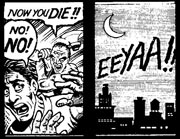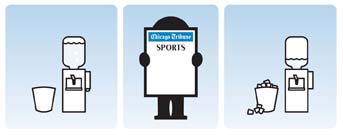Comic Theory 101: In Place of Another
This article was originally written for my periodic column at the online magazine Comixtalk in October 2005.
One of the most famous theories that Scott McCloud set forth in Understanding Comics was that of “closure.” He stated that this was the phenomenon by which people’s minds “fill in” what occurs between two comic panels. Now, in other writings of mine, I’ve argued that any linear panel-to-panel explanation of how people understand sequences of images has multiple problems. However, in this piece, I’d like to take aim at one particular example of McCloud’s and use it to illuminate a broader phenomenon that occurs in both visual and verbal expression.The following is one of McCloud’s key examples for the existence of closure:

Describing why this example supports the idea of closure, he states:
I may have drawn an axe being raised, but I’m not the one who let it drop or decided how hard the blow, or who screamed, or why. That, dear reader, was your special crime, each of you committing it in your own style. All of you participated in the murder. (p. 68)
However, here McCloud pulls off a deft rhetorical trick, because, in fact, he is the one who creates the ambiguity in the murder. McCloud presents a second panel with a cityscape and a scream instead of showing the murder itself. Because of the relationships of screams to terrified victims, we understand that the murder occurs in that frame. But, that murder doesn’t creatively happen in our minds because of the space between the panels, it happens in our minds because McCloud chose not to show it in the panel directly.
The technique that McCloud uses in the second panel is called metonymy — creating the meaning for something by showing a related thing. This occurs in speech very often, as in the highlighted parts of these sentences:
- The White House leaked a story to the Times.
- The ham and cheese ordered a soda too. (said by a waitress to another)
- Lend me your ears!
In the first sentence, the terms White House and Times are used to refer to the people within their organizations, not to the physical building and a newspaper. In the second, a famous example in linguistics, the meal that the person ordered stands in for their identity to the speakers. Finally, when someone announces the third sentence, they don’t mean that they want people to give them their ears literally, but that they want them to listen to what they have to say. Ears refers to the act of hearing, and the people doing that act.
Metonymy can take on various characteristics, as evident in the examples above. The first sentence uses a place or organization to refer to their affiliated people, the second uses an object as a person, and the third uses an object to refer to an action (not to mention a part of a person to refer to the whole).
As McCloud skillfully shows, metonymy can be equally effective in the graphic form as well, and all of these types apply. For example, just like the first sentence, Gary Trudeau often uses an image of the White House in place of the individuals in his Doonesbury strips.
Metonymy is often used to humorous effect in a variety of Butternutsquash strips. Here, Ramon’s expressions allow the reader to fabricate what happens to Rob off-panel. The act is never shown or even described — it is only insinuated through our knowledge of Ramon’s mimicking responses watching what happens to Rob.

Metonymy was also a technique used in various advertising strips by the Chicago Tribune, such as this one:

The watercooler in the first and last panels stands as a place that people gather to talk in an office. The difference of a full versus empty tank and trashcan imply that people have been around it in the last panel, while they haven’t in the first. The second panel insinuates then that reading the “Sports” section of the paper will give you something to talk about at work. Indeed, since the only presence of any people in the strip is in the second panel the individualreading the paper also can stand for multiple people (part to whole), since reading the sports section is the common ground would allow for group discussion.
Metonymy can be used in all sorts of ways graphically. A panel might show the trigger of a gun being pulled instead of a whole person firing it (part to whole). You can show a seagull to imply the setting of a beach. Open band-aid wrappers can show that someone needed medical aid. Really, the possibilities are as boundless as the ideas that people come up with.
Metonymy in the graphic form once again shows the similarities between the verbal and visual domains. It can provide a creative and evocative technique to graphic rhetoric, not to mention providing us theorists some good food for thought.
Comments